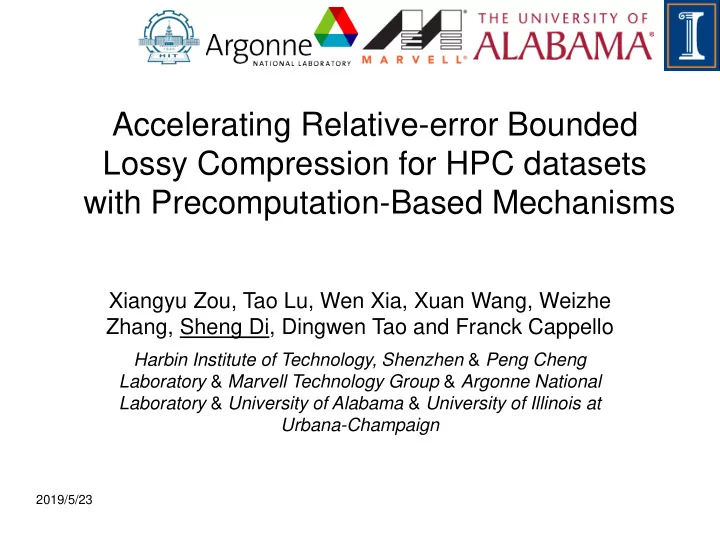

Accelerating Relative-error Bounded Lossy Compression for HPC datasets with Precomputation-Based Mechanisms Xiangyu Zou, Tao Lu, Wen Xia, Xuan Wang, Weizhe Zhang, Sheng Di, Dingwen Tao and Franck Cappello Harbin Institute of Technology, Shenzhen & Peng Cheng Laboratory & Marvell Technology Group & Argonne National Laboratory & University of Alabama & University of Illinois at Urbana-Champaign 2019/5/23
Outline • Background of research • Our design • Evaluation • Conclusion 2 / 21
Background • Scientific simulations • Climate scientists need to run large ensembles of high-fidelity 1kmX1km simulations. Estimating even one ensemble member per simulated day may generate 260 TB of data every 16s across the ensemble. • Cosmologicaly simulation may produce 40PB of data when simulating 1 trillion of particles in hundreds of snapshots. • Data reduction is required • Lossless compression • Simulation data often exhibit high entropy • Reduction ratio usually around 2:1 • Lossy compression • More aggressive data reduction scheme • High reduction ratio 3 / 21
Background - Lossy compressors • ZFP • follow the classic texture compression for image data • Data transformation + embedded coding • Low compression ratio , High compression speed • SZ • Prediction + quantization + Huffman encodng + Zstd • High compression ratio, Low compression speed • A dilemma: which compressor should I use? • Question: Can we significantly improve compression speed for SZ, leading to an easy solution for users? 4 / 21
Background - Lossy compression error bound • Absolute error bound • For a value f, we get f’ ∈ ( f - ε, f + ε ) is acceptable • Pointwise relative error bound • For a value f, we get f’ ∈ ( f * (1 - ε), f * (1 + ε) ) is acceptable • CLUSTER18: Convert a pointwise relative error bound to an absolute error bound with a logarithmic transformation • log(f*(1 - ε))=log(f)+log(1 - ε), log(f*(1 + ε))=log(f)+log(1 + ε) • log(f’) ∈ ( log(f) + log(1 - ε ), log(f) + log(1 + ε)) 5 / 21
Background – design of SZ compressor for relative error control • Preprocess - Logarithmic transformation • Point-by-point processing – prediction & quantization • Huffman encode • Compression with lossless compressor Logarithmic transformation (logX) is too expensive! 6 / 21
Performance breakdown of SZ Compression/Decompression Time costs on log-trans and exp-trans stages consist about 1/3 of the total 7 / 21
Our design - workflow • No longer to calculate the quantization factor, but look up tables. • Using Table T1 to get quantization factor from f • Using Table T2 to get a approximate value of f from quantization factor 8 / 21
Our design - Model A 9 / 21
A general description to model A PI interval 10 / 21
Our design - Model B 11 / 21
A general description about model B 12 / 21
Our design - Advantage of Model B • Any grid (i.e., a data point) is always included in a PI’ • Grid size is smaller than any intersection size, therefore any grid is completely included in one PI’(M) • Effect: Strictly respecting the use-specified error bound 13 / 21
Accelerating Huffman decoding Idea: building precomputed table to accelerate Huffman decoding 14 / 21
Performance Evaluation • Environment • Datasets • 2.4GHz Intel Xeon E5-2640 v4 • NYX (3D, 3.1GB) processors • CESM (2D, 2.0GB) • 256GB memory • Hurrican (3D, 1.9GB) • HACC (1D, 6.3GB) 15 / 21
Compression/Decompression Rate Our Approach is about 1.2x ~ 1.5x than original SZ on compression rate and 1.3x ~ 3.0x on decompression rate 。 16 / 21
Compression/Decompression breakdown No time cost on log-trans and exp-trans. Time cost on build-table stage is very small. 17 / 21
Compression Ratio We can observe that our solution (SZ_T) has very similar compression ratios with SZ_T. 18 / 21
Data quality Comparable compression ratios with related works (SZ_T and ZFP_T) 19 / 21
Data quality (Cont’d) Visualization of decompressed dark matter density dataset (slice 200) at the compression ratio of 2.75. SZ series has a better visual quality than ZFP does. SZ_P (both mode A and B) lead to satisfied visual quality! 20 / 21
Conclusion • We accelerate the SZ compressor for point-wise relative error bound control by designing a table- lookup method. • We control the error bound strictly by an in-depth analysis of mapping relation between predicted value and quantization factor. • Experiments show that 1.2x ~ 1.5x on compression speed and 1.3x ~ 3.0x on decompression speed, compared with SZ 2.1. 21 / 21
Thank you Contact: Sheng Di (sdi1@anl.gov) 2019/5/23
Recommend
More recommend